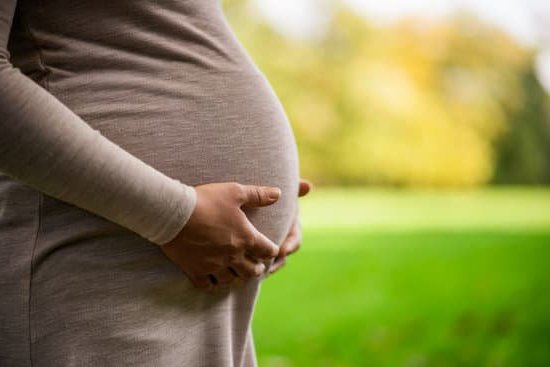Introduction
Tailbone pain after pregnancy is a common symptom experienced by some women. It can also be known as coccydynia and is usually caused by the strain of carrying a baby during pregnancy, or from lifting heavy objects during labor. Other common issues a woman may experience after pregnancy are pelvic floor issues such as urinary incontinence and prolapse, weakened abdominal muscles leading to separation (diastasis recti), sleep deprivation and fatigue, mood swings and depression, hormonal changes, joint pain due to strain or injury during delivery or breastfeeding, back pain due to the additional weight put on the body during just nine months, vaginal dryness and discomfort due to estrogen depletion post-birth, gestational diabetes that may persist throughout a woman’s life if not treated during pregnancy, as well as thrush infection in both mother and baby.
Different Types of Tailbone Pain After Pregnancy
Tailbone pain after pregnancy is a common problem that many women experience. This type of pain occurs in the area of the coccyx or the lower part of the spine which carries your baby during pregnancy. It can range from mild discomfort to severe pain that makes it difficult to sit or stand for prolonged periods of time. Common causes include pushing and pulling during labor, changes in your center of gravity due to carrying a baby, and an increased curvature in your spine as your body adjusts to postpartum weight gain.
There are generally three types of tailbone pain after pregnancy: acute pain, chronic pain, and referred pain. Acute tailbone pain usually happens suddenly and will typically last for only a few days if it is not relieved by rest or other measures. Chronic tailbone pain persists for more than four weeks and may become worse with sitting or activities like running or jumping. Referred tailbone pain is felt in various parts of the body due to nerve irritation from compressed nerves around the tailbone. Treatment plans may include rest, medications, physical therapy stretches, injections, surgery, and lifestyle changes such as reducing weight gain and avoiding sitting for extended periods of time.
Causes of Tailbone Pain After Pregnancy
Tailbone pain after pregnancy is a relatively common complaint among women after they have given birth. The medical term for this condition is coccydynia and it is associated with some of the postural changes that occur during and after pregnancy. Some of the most common causes of tailbone pain are:
• Muscular strain – During pregnancy, your pelvic muscles can become weakened due to an increased amount of weight being carried by them, causing them to be easily strained during childbirth. This can lead to pain in the lower back and in your tailbone area.
• Prolonged sitting or standing – Carrying extra weight around in the form of a baby creates pressure on your spine and other areas like your hips, making it difficult to maintain proper posture while sitting or standing in one place for extended periods of time. This can cause discomfort in your tailbone area as well as the rest of your spine.
• Poor posture – It’s not uncommon for a woman’s posture to suffer during pregnancy because she’s trying to accommodate her growing baby bump. Poor posture can increase stress on the spine and result in pain throughout the body, including the tailbone area.
• Scar tissue – In some cases, childbirth can leave behind scar tissue which may press on nerves in the area, leading to pain when sitting down or engaging in certain activities.
Symptoms of Tailbone Pain After Pregnancy
Tailbone pain after pregnancy is incredibly common. It can range from mild to severe, and can affect a woman’s ability to move around comfortably and perform everyday tasks. Symptoms can include problems such as pain when sitting, standing or lying down; difficulty with mobility; sharp or dull pains in the area near the tailbone; and tenderness when putting pressure on the area. Some women may even experience issues with faecal incontinence, due to damage that has been caused to their pelvic floor muscles. In addition, tailbone pain after pregnancy can be accompanied by inflammation, redness or swelling in the surrounding areas. Women who are suffering from this type of pain should seek medical attention if they feel any persistent symptoms related to the condition.
Natural Treatments for Tailbone Pain After Pregnancy
Tailbone pain can be very uncomfortable and is a common side effect of pregnancy. It may take several months to heal if left untreated. Fortunately, there are several natural treatments that you can use to help alleviate this pain after childbirth:
1. Ice/heat therapy – Applying ice to the area or taking a warm bath can provide relief by reducing inflammation.
2. Massage – Massaging your tailbone area with an essential oil such as lavender, or even coconut oil, can release muscle tension and promote relaxation.
3. Stretching/yoga – You can do stretches that target the pelvis and back muscles to help relieve tightness, restore range of motion and reduce compression on the tailbone. A gentle yoga routine designed for postpartum recovery is also beneficial for promoting healing and improving posture after giving birth.
4. Ergonomic support – Supporting your spine with pillows when sitting or using a doughnut-shaped cushion for better comfort may help reduce pressure in the tailbone area and become more bearable.
5. Diet & lifestyle adjustments – Eating anti-inflammatory foods like dark leafy greens, salmon, probiotics and good fats like olive oil may help reduce inflammation caused by the injury while maintaining overall health during the healing process. Getting plenty of rest, doing light physical activity such as walking, deep breathing exercises and relaxation techniques like meditation will all ensure that your body has enough energy to focus on healing itself from any difficulties it encountered during pregnancy or labor .
Medical Treatments for Tailbone Pain After Pregnancy
Tailbone pain after pregnancy can be a very uncomfortable experience. Fortunately, there are several medical treatments available to alleviate this type of pain. People who suffer from tailbone pain may find relief with physical therapy or steroid injections. Physical therapy is especially effective in strengthening abdominal muscles, which can reduce pressure on the tailbone and help relieve negative symptoms. Steroid injections can help lower inflammation and irritation in the area around the tailbone, making sitting and lying down significantly more comfortable. In extreme cases, surgery may be suggested to remove inflamed tissue that is causing excessive discomfort. Other treatments for tailbone pain include medications such as anti-inflammatory drugs and pain relievers, as well as lifestyle changes like avoiding prolonged periods of sitting still or wearing supportive clothing to reduce tension placements on the affected joints.
Prevention of Tailbone Pain After Pregnancy
Tailbone pain following pregnancy is a common complication of child birth. This condition is generally treated with rest, heat or cold therapy, or medications prescribed by a physician. To prevent tailbone pain during and after pregnancy, there are several steps a woman can take. These include:
• Wearing appropriate supportive garments such as maternity belts and girdles.
• Maintaining good posture while sitting and standing to reduce the strain placed on the tailbone area.
• Staying active throughout pregnancy; light strengthening exercises can be helpful in toning muscles which support the area around the coccyx bone.
• Avoiding rigorous activities that may cause jarring or strain to the tailbone such as running, bouncing, skipping, and jumping.
• Taking breaks from prolonged sitting/standing as often as possible to allow for movement and circulation of blood flow in the area.
• Utilizing soft seating surfaces when possible such as an Engergizing Foam cushion which provides lumbar support without affecting mobility when seated.
• Applying warm compresses or cold packs to the affected area can help reduce muscle tension and discomfort associated with tailbone pain.
When to See a Doctor for Tailbone Pain After Pregnancy
Tailbone pain after pregnancy can be a very uncomfortable and even unbearable experience for some. It should not be ignored or put off until it becomes more severe. If you are experiencing any kind of tailbone pain after pregnancy, you should speak to your healthcare provider right away. They can provide diagnosis and treatment.
Your doctor will likely do a physical examination and take an imaging study such as an X-ray or MRI in order to better understand your condition. This will allow them to create a tailored treatment plan based on the severity of your symptoms. Possible treatments could include stretching, strengthening exercises, therapeutic massage, physical therapy, lifestyle modifications such as avoiding sitting for long periods of time or using special cushions when sitting, and medications such as ibuprofen or acetaminophen for pain relief if necessary. In some rare cases surgery may be needed to address tailbone pain after pregnancy if other treatments have been unable to improve symptoms.
Tips for Managing Tailbone Pain After Pregnancy
Tailbone pain is a common postpartum symptom that many new mothers experience after childbirth. The pain can vary in severity and range from dull ache to intense discomfort. Fortunately, there are several ways that women can manage or reduce the associated discomfort and facilitate a speedy recovery.
One of the best methods for managing tailbone pain after pregnancy is to keep the area mobile and maintain good posture while seated. Gentle stretching exercises specifically designed for tailbone pain can also help to alleviate pain and tightness. It is advisable to avoid sitting for extended periods of time, practice yoga poses that involve hip and back stretches, use an ergonomic cushion when sitting, stay active by walking or swimming regularly and apply cold compresses or ice packs to the affected area for 20 minutes at a time several times per day. Soothing heat therapy can also be helpful. Women experiencing severe tailbone may need to consider taking medications such as ibuprofen, acetaminophen or even stronger muscle relaxants prescribed by their physician. Women should also consult their healthcare provider before using any over-the-counter supplements or herbal remedies as some ingredients may not be safe during pregnancy.
Diet and Nutrition Ideas to Help with Tailbone Pain After Pregnancy
One way to help manage tailbone pain after pregnancy is to focus on a nutrient-rich diet. Eating nutrient-packed meals can help reduce stress and inflammation, allowing the body time to heal and repair. Women should focus on eating plenty of leafy greens, fruits, legumes, nuts, and whole grains. Additionally, incorporating sources of omega-3 fatty acids like fish oil or flaxseeds can help reduce inflammation throughout the body and alleviate some pain symptoms. Getting plenty of liquids throughout the day is also important for reducing inflammation and getting proper hydration; this means drinking both water and other non-caffeinated beverages like herbal tea. Additionally, women should avoid eating processed foods that are high in saturated fat or added sugars as they may worsen inflammation in the body. Finally, adding in regular exercise as part of a healthy recovery process can make a big difference; gentle stretching and low impact aerobics are ideal activities to ease discomfort while raising heart rate without putting excess strain on the back area around the tailbone.
Supportive Practices that Help Tailbone Pain After Pregnancy
Tailbone pain after pregnancy is a common and sometimes painful symptom experienced by many new mothers. Fortunately, there are several supportive practices which can help to alleviate tailbone pain following childbirth.
One practice which helps to reduce tailbone pain is stretching. Many postpartum women find it beneficial to perform stretches that target the pelvic floor and hip flexors as this helps to decrease tension in the lower back area. Using a foam roller on affected areas can also provide relief from soreness or discomfort related to tailbone pain. Additionally, participating in low-impact aerobic activities such as swimming or gentle yoga can help improve circulation and mobility of muscles around the spine and pelvis.
In addition to exercise, proper nutrition is essential for managing symptoms of tailbone pain after pregnancy. Postpartum mothers should be sure to get enough protein, calcium, and vitamin D in their diet as these nutrients aid in strengthening our bones and reducing inflammation. While getting adequate amounts of water is important for everyone’s health, it can be especially beneficial for pregnant mothers struggling with tailbone discomfort since proper hydration helps flush out toxins from the body. Finally, eating probiotic rich foods such as kefir or yogurt may improve gut health which could also contribute positively towards reducing tailbone pain post-pregnancy.
Conclusion
Tailbone pain after pregnancy is a common issue that mothers face when they go through childbirth. While it can be painful and uncomfortable, there are several ways to relieve this type of pain. A support belt worn over the tailbone area has been proven to reduce some of the discomfort experienced by postpartum women. Regular stretching and strengthening exercises can also help to reduce pain while encouraging the muscles in the pelvic area to heal properly. Additionally, warm baths have been known to help soothe tight muscles in the underlying tissues and provide some much-needed relief from postpartum pain around the tailbone area. Ultimately, proper care and attention should be given once a mother experiences tailbone pain following childbirth as ignoring these symptoms for an extended period of time could lead to chronic problems further down the line. Therefore, new moms shouldn’t hesitate to seek medical help if things do not improve after trying out the mentioned remedies.

Welcome to my fertility blog. This is a space where I will be sharing my experiences as I navigate through the world of fertility treatments, as well as provide information and resources about fertility and pregnancy.





